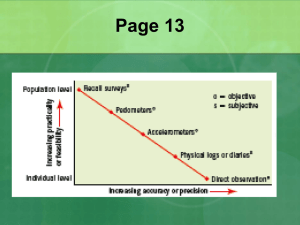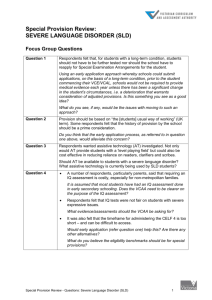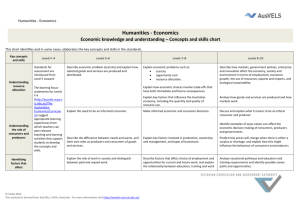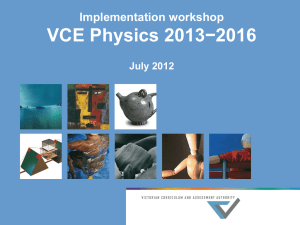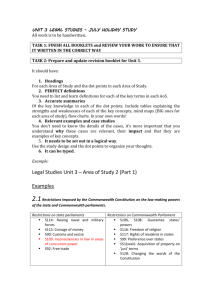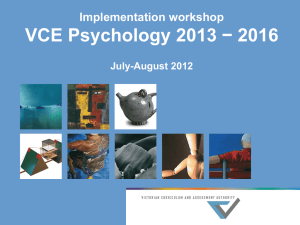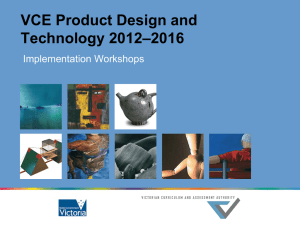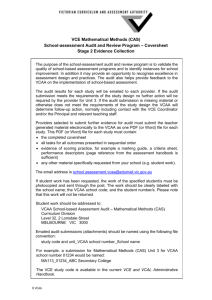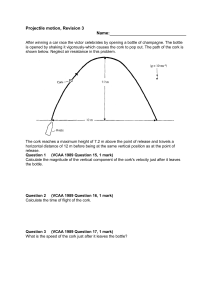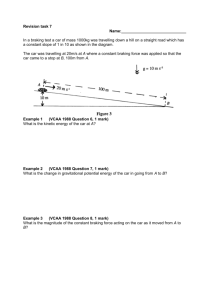Dumb ways to die
advertisement
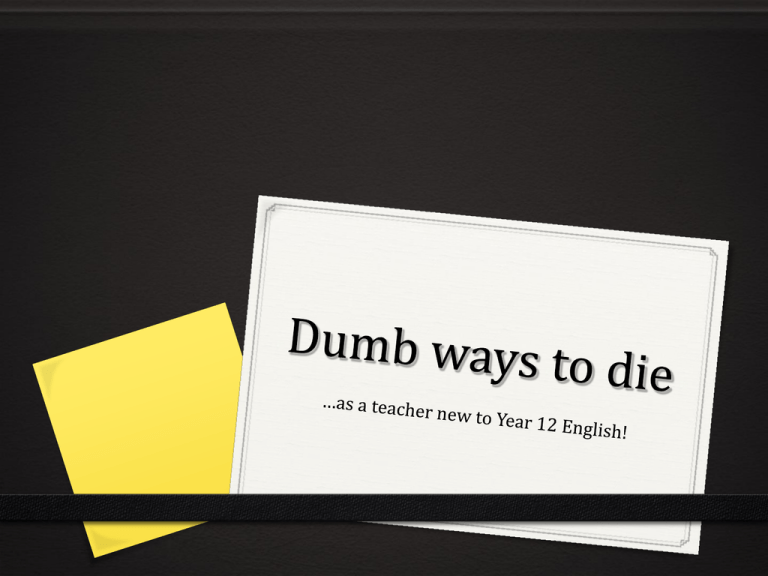
1. You don’t know the VCAA requirements At the end of today you will: 1. Have seen the entirety of the course 2. Have considered the assessment requirements 3. Have access to some practical planning and teaching tools to help get you started. 2. You take student results personally You can lead them to water, but you can’t make them drink. We will look at the importance of: 1. Cross-marking 2. Assessment rubrics 3. Effective feedback 3. You forget to have a life If you aren’t enjoying it, they won’t be either. A quick glance at: 1. Creating positive learning environments 2. Working with young adults 3. Managing stress – yours and theirs. 1. VCAA Requirements The big picture Unit 3 English - Outcome 1: Reading and responding - Outcome 2: Creating and presenting - Outcome 3: Using language to persuade Unit 4 English - Outcome 1: Reading and responding - Outcome 2: Creating and presenting Final examination - 30th October 2013 1. VCAA Requirements Assessment Unit 3 Overall 25% - Outcome 1 30 marks Written analysis - Outcome 2 30 marks Written response (1 longer or 3 smaller) - Outcome 3 20 marks Oral presentation 20 marks Written analysis Unit 4 Overall 25% - Outcome 1 50 marks Written analysis - Outcome 2 50 marks Written response (1 longer or 3 smaller) Overall 50% Three essays Examination GAT & Indicative grades • The GAT is used to predict how students will perform and is a back-up for calculating a result if there are any unforeseen circumstances. • Indicative grades must be submitted: This grade indicates how you expect your students to perform in their final examination. • You should receive a statistical analysis of these results for the cohort and for your individual class. 1. VCAA Requirements Outcome 1: Text study Analysing a text for: • • • • • Meaning Character Plot Literary devices Themes Assessment: Formal analytical essay 1. VCAA Requirements Maximising outcomes Deliberately teach essay structure, including TEEL. Specific examples, including quotes Knowing the context of the writing and the author’s intention. Deliberate use of metalanguage Extended vocabulary 1. VCAA Requirements Outcome 2: Creating & Presenting • Imaginative landscapes • Encountering conflict • Exploring issues of identity and belonging • Whose reality? • Assessment: Written response – expository, persuasive and/or imaginative. 1. VCAA Requirements Maximising outcomes Covering a wide variety of issues within the context Empowering students to find their writing strength Expository essay Persuasive essay Imaginative Stressing the importance of actually answering the question they are given. 1. VCAA Requirements Outcome 3: Using language to persuade Analysing various media genres Identifying • Overall issue • Articles • Main contention • Blogs • Tone • Speeches • Style • Opinion pieces • Visual • Advertising • Supporting arguments • Persuasive techniques • Impact on the reader. ULTP Essay planning table What is the topic of the article? (p.11&12) Article reference: What is the main contention? (p.11&12) Introduction What is the tone? (p.7) What is the writing style? (p.5&6) Supporting Argument Technique & Quote Impact (p.29-31) Body para’ #1 Body para’ #2 Body para’ #3 Conclusion The concluding argument 1. VCAA Requirements Maximising outcomes Stressing the importance of argument and impact. Don’t define the techniques but do use examples that show you understand what they mean. Strong essay structure – no formal conclusion, simply analyse the conclusion of the piece. Commenting on any visuals – ignoring the visuals will lose you marks. Examination strategy: Read the article/piece for Outcome 3 during the Reading time 1. VCAA Requirements Final Examination: th 30 Oct • Three essays in three hours: one for each of the outcomes. • Preparation • Timed responses • Making the most of the September break • Practice exam • Example pieces • Keeping up with the marking • Marking like you are an assessor – out of 10, using a bell curve, where 5 is average. 1. VCAA Requirements Examination strategies • During Reading time: • Read the questions for your texts only. • Read the written piece for Outcome 3 and begin planning in your mind – don’t touch your pens. • Make sure you read the Background information given for Outcome 3 – it will often tell you about the issue and the target audience • Answer Outcome 3 first • Be disciplined about time: 1 essay per hour (5 minutes planning, 55 minutes writing). 2. Student results Cross-marking 2. Student results Assessment rubrics 2. Student results Effective Feedback • Commenting on student work • Keep it positive • Be specific • Give them something they are doing right • Something they can continue to do next time they write • Something to work on for next time 2. Student results Effective feedback 3. Having a life Creating positive learning environments • The better prepared you are, the better things will go. • Knowing what you are aiming to do each lesson will keep you on track • Help students verbalise what they have learned in that class by setting aside 5 minutes at the end to go around the room and have everyone say “What I learned today was…” • This gives you immediate feedback of any misunderstandings • Gives you the opportunity to affirm students. 3. Having a life Working with young adults • They aren’t kids, don’t treat them like they are. • Show respect and expect respect in return. • Be interested in what they like. • Be open to learning from them – they have terrific ideas. • Be ready to laugh (at yourself and with them) • Don’t take it personally – you don’t really know what life is like for them. 3. Having a life Managing stress – yours and theirs • It’s stressful. • Remember to give yourself permission to not think • • • • about it. Be aware of when you are getting sick – take time off. Don’t say it. Occasionally remind them that their lives don’t actually hinge on this one exam. Remember: chocolate makes everything better Thank you for listening
